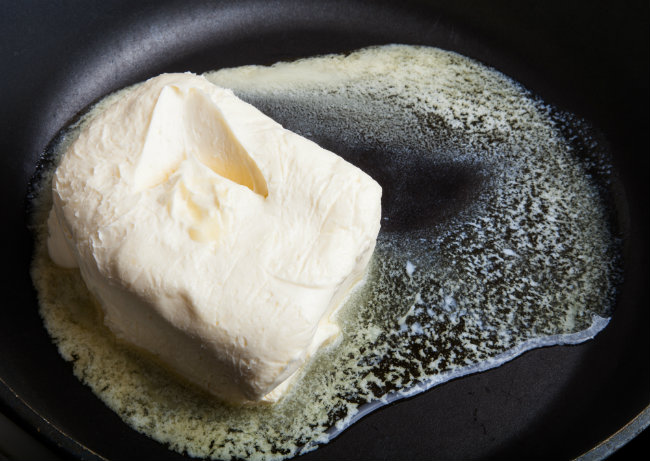 When we hear the word “fat” nothing good comes to mind.
When we hear the word “fat” nothing good comes to mind.
We see all those tee-shirts that say stuff like, “Sweat is just fat crying” and “I wear black when I workout because it’s like a funeral for my fat”.
Fat is the thing nobody wants.
The word carries a greasy, scoop-of-lard kind of feeling to it that causes instant repulsion. So no fat, low fat, please-don’t-let-me-ever-be-fat. That’s the mentality we gravitate towards.
So when it comes to trying to eat healthy we often think, “If I workout hard so I don’t have extra fat, why would I eat food with fat in it?”
Fat makes you fat… Right?
Well… not so fast. Fat may be getting a bad rap that it doesn’t fully deserve. Fat is a pretty broad term and the truth is that not all fats are equal.
Back in the 80’s and 90’s “low-fat” was the big diet trend. Everyone was into low-fat this and that… Eat margarine instead of butter and do your aerobics with leg warmers… That’s what was sold as being “healthy”.
But modern research has made significant strides in helping us understand more fully what it means to eat nutritiously. And it turns out that demonizing all fat was a mistake.
The fact is, we all need good fat. High quality fat in the proper amounts actually helps our bodies function properly, perform well in the gym, and even maintain a healthy weight.
Before we jump into talking about excellent sources for good fat, let’s talk about the primary sources of bad fat. Two in particular immediately come to mind:
Overly-Processed, Pre-Packaged Food
Low-quality, highly-processed foods that you find in the middle aisles of the grocery store usually lack even small amounts of nutritional quality – no matter what health claims the bright label boasts. Research comes out all the time that shows that a diet formed with kind of food is doing incredible amounts of damage to our bodies and is one of the primary reasons people find themselves unhealthy and overweight. So fat from sources like this is never a good idea.
Rich, Fried Food From Restaurants.
And then there’s restaurants… I don’t know how, but restaurants find a way to sneak in more fat and sodium in food than even seems scientifically possible. Spend an hour looking up all the nutrition facts on your favorite restaurant dishes and you’ll be shocked and disgusted. Some dishes like chili-cheese fries will come as no shock, but the dishes that advertise things like “pan seared chicken” or “garden-fresh salad” are often laden with fat, cheese, bready croutons, and rich dressings. And most things are cooked in abominable amounts of cheap oil.
Not good.
But let’s talk about good fat. Taking in moderate amounts of high quality fat from natural sources can help improve mood and brain function, build muscle, and help with weight loss. So what are some good sources of fat?
Just a few favorites are:
– Almond Butter
Almond butter can be added to smoothies to give them a heartier flavor and for added protein and it can also be used as a spread to top apples for a good snack.
– Coconut Oil
Coconut oil can be purchased in different forms. Some coconut oil has that coconut flavor to it which is actually very tasty in many foods. You can also buy coconut oil that doesn’t have the coconut flavor if you have an aversion to it. The uses are endless. Besides sautéing veggies, pan searing lean proteins, and using it to flavor grains like brown rice and quinoa, I’ve heard of people using it as deodorant, coffee creamer, skin moisturizer, and many other things. I’m not at all saying that I’ve personally given all those ideas a try so attempt at your own risk.
– Cold-Pressed, Extra Virgin Olive Oil
If you use extra virgin organic olive oil, you will benefit from higher levels of antioxidants, especially vitamin E and phenols, the same compounds found in grapes, because the olive oil is less processed. While the benefits are incredible, it’s still important to use moderation – you can get carried away drowning your veggies and salads in oil if you’re not mindful.
– Avocados
Avocados are incredibly versatile… They can be used to top soups, salads, and many other dishes. They also serve as a great substitution for condiments such as mayo and salad dressing and can also be used as a fat content in baked dishes that would typically call for butter.
– Nuts… Such as Almonds, Walnuts, and Pistachios.
Nuts are rich in protein and good fat… But again, make sure you’re getting the good stuff. Some nuts have been processed, fried, and are overly salted which makes the benefits of eating them go down considerably.
– Fish
Fish (such as salmon) might have a higher fat content on the label but it’s rich in Omega 3s and is a great source of protein. Fantastic addition to your weekly menu plan.
When purchasing these kinds of healthy-fat products, you want to make sure you’re getting top quality. It’s worth spending a few extra dollars to keep it natural and organic if possible.
So shy away from bad fat, but don’t throw the baby out with the bathwater. Enjoy good, healthy fat as a part of your diet – just in moderation.
It matters where you’re getting your fat.
